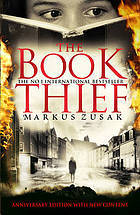Cross-posted from Goodreads
“And when Death tells a story, you really have to listen,” announced the backcover when I picked up the book. At first, the book’s theme sounded morbid and grim. What it actually turned out to be was an (almost) warm story of a young german girl trapped in—what appears to her still-evolving sense of the world as—weird and unintuitive ways of a warring Nazi Germany. It’s her love of books (and words) that lays the foundation of the story. Without using dramatic effects, the author does a great job of underlining the sheer power of words in making and breaking the world around us.
Of course, there’s a lot of death and suffering involved. But when narrated by Death in a matter-of-factly voice, the story doesn’t sound poignant at all. Instead, the narration style makes it easy for a reader to pick up the joys and miseries of everyday life in a warring nation-state driven by a megalomaniac of a narcissist who is a death-giver (to Jews) and death-inviter (to the rest of Germany).
The plight of Jews is brilliantly highlighted in stark details, without the need to go too deep into the horrors of concentration camps. What’s even more brilliantly described is the attitudes of regular German citizens during those testing times. In the end, friendship trumps race in a dazzling display of warm and complex human emotions.
In some ways, I was frequently reminded of To Kill a Mockingbird. I could see parallels between the two books in terms of the protagonist being a young girl, the depiction of an idyllic lifestyle, and nonconformist views against racism.
Markus Zusak uses simple words and a creative narration to describe a painful setting. I especially liked his use of callout annotations throughout the book.
This book was recommended to me by a dear old friend, Aman Mehra.
